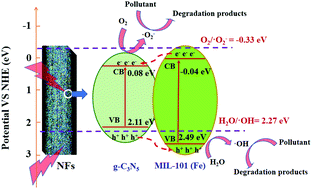Sustainable and reusable electrospun g-C3N5/MIL-101(Fe)/poly(acrylonitrile-co-maleic acid) nanofibers for photocatalytic degradation of emerging pharmaceutical pollutants†
Abstract
The fabrication of sustainable and reusable photocatalyst materials is urgent and desirable for the removal of emerging pharmaceutical pollutants (EPPs) in environmental water samples. In this work, we described the fabrication of electrospun nitrogen-rich carbon nitrides/MIL-101(Fe)/poly(acrylonitrile-co-maleic acid) nanofibers (E-spun g-C3N5/MIL-101(Fe)/PANCMA NFs) by using electrospinning dispersion solutions of g-C3N5/MIL-101(Fe) and PANCMA, as well as their applications as sustainable and reusable photocatalysts toward a model EPP carbamazepine degradation under light irradiation. The E-spun g-C3N5/MIL-101(Fe)/PANCMA NFs exhibited the highest carbamazepine degradation efficiency of 94.2% within 40 min. The O2˙−, ˙OH, and h+ reactive species all participated in the photodegradation process, and some degradation byproducts of carbamazepine were identified by liquid chromatography-mass spectrometry. Importantly, the electrospun photocatalyst possessed high reusability (at least 15 consecutive runs) and wide applications in the degradation of other EPPs (such as tetracycline and ciprofloxacin), which suggested the great potential of the electrospun photocatalytical nanofibers in the EPPs removal.



 Please wait while we load your content...
Please wait while we load your content...